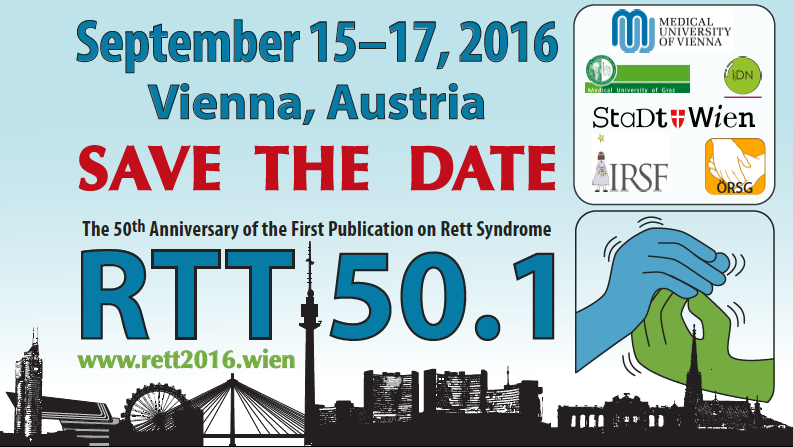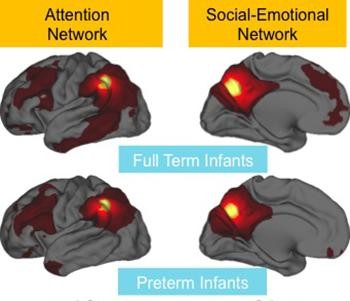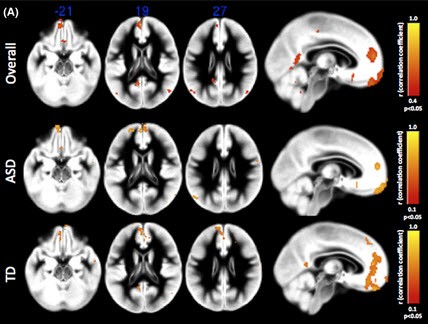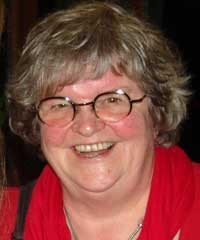
- Details
- ICNA
- News
- Hits: 656
The 50th anniversary of the first publication on Rett Syndrome by Andreas Rett is being celebrated with an international conference RTT 50.1, from 15th to 17th September 2016 in the historic city of Vienna, home to Andreas Rett and 'birthplace' of Rett syndrome.
RTT 50.1 is open to patients, clinicians, scientists, researchers and other healthcare professionals. Keynote lectures, oral presentations and posters aim at outlining History, (R)Evolution in Rett Syndrome, State of the Art and RTT50.1 – future trends and developments – what can we expect?
Please see the congress website at www.rett2016.wien for further details and to sign up to the congress newsletter.
ORGANIZING COMMITTEE (Scientific & Local Organizing Committee)
Michael Freilinger (Vienna, AT)
Peter B Marschik (Graz, AT – Stockholm, SWE)
Christa Einspieler (Graz, AT)
Alan Percy (Birmingham, AL, USA)
Walter E Kaufmann (Boston, MA, USA)
Leopold MG Curfs (Maastricht, NL)
Further reading:
Rett A. [On a unusual brain atrophy syndrome in hyperammonemia in childhood]. Wien Med Wochenschr. 1966 Sep 10;116(37):723-6. German. PubMed PMID: 5300597.
Read More

- Details
- Dr Paolo Curatolo
- News
- Hits: 652
Dear friends,
It is my pleasure to invite you to attend an International Symposium on "Is autism a treatable disorder"?. This satellite meeting for the ICNC 2016 will be held in Rome on April 29th 2016.
The aim of this Symposium is to allow basic neuroscientists working on autism research and clinicians to meet together and discuss new advances in biologically based treatments of autism spectrum disorders. The Symposium will review recent progresses on molecular understanding of pathophysiology of autism spectrum disorders and will discuss current and future approaches to treatment with a special focus on translational research.
Free oral presentations on the topic of the Symposium are welcome. The congress will be held at NH Hotel GiustinianoVia Virgilio, 1 0093 Roma
Please visit the website http://www.ptsroma.it/autismtreatment
I am looking forward to welcome you all,
Paolo
Prof. Paolo Curatolo
Past President, ICNA
Director
Pediatric Neuroscience Unit
"Tor Vergata" University Hospital
Rome, Italy
Read More

- Details
- ICNA
- News
- Hits: 611
In their research "Impact of preterm birth on structural and functional connectivity in neonates" presented at the Society for Neuroscience (SFN) conference in Chicago, Oct 19, 2015, Cynthia Rogers and her colleagues at Washington University Neonatal Development Research Lab, Washington University School of Medicine in St. Louis have found that key brain networks involved in attention, communication and emotion were weaker in premature infants, suggesting an explanation for why children born prematurely may have an increased risk of psychiatric disorders.
They used functional magnetic resonance imaging and diffusion tensor brain imaging to compare 58 babies born at full term with 76 infants born at least 10 weeks early. Each full-term baby was scanned on his or her second or third day of life. Each premature baby, meanwhile, received a brain scan within a few days of his or her due date. The study found significant differences in the white matter tracts and abnormalities in brain circuits in the infants born early, compared with those of infants born at full term.
The researchers also found differences in the preterm babies resting-state brain networks, particularly in a pair of networks previously implicated in learning and developmental problems. Among these resting-state networks is the default mode network, which tends to be most active when people are least active. The greatest differences between full-term and preterm babies were seen in this network and in the frontoparietal network. Both encompass brain circuits associated with emotion and previously have been linked to ADHD and autism spectrum disorders. ICNApedia had earlier reported on an UCLA study which reported that brain areas linked to social behaviors are both underdeveloped and insufficiently networked in youths with high functioning autism spectrum disorder (ASD). The UCLA study found increased local functional connectivity (FC) in the anterior module of the default mode network (DMN) accompanied by decreased CBF in the same area. In the United States one of every 9 nfants is born prematurely and, thus, with increased risk of cognitive difficulties, problems with motor skills, and attention deficit-hyperactivity disorder (ADHD), autism spectrum disorders and anxiety.
According to the Cynthia and her team at Washington University School of Medicine these brain circuit abnormalities are likely to contribute to problems as the children get older. They are continuing to follow the babies, having completed follow-up evaluations when the children reached age 2, and again on some at age 5. The researchers plan another series of brain scans in a few years as the original study participants reach the ages of 9 or 10. The findings of these study are very encouraging and suggest a role for early intervention in influencing the long term outcome following preterm birth. {audio}101489.mp3{/audio}
Cover image: A comparison of brain scans from babies born at full term and at least 10 weeks prematurely shows differences in the activity of brain networks. The red and yellow areas represent coordinated activity. In preemies, the red areas are smaller due to less coordinated activity between these regions. (Credit: Washington University School of Medicine)
Read More

- Details
- ICNA
- News
- Hits: 634
In a study from UCLA published in the online issue of the peer-reviewed journal Brain and Behavior, Jann and colleagues have found that brain areas linked to social behaviors are both underdeveloped and insufficiently networked in youths with high functioning autism spectrum disorder (ASD) compared to study participants without ASD.
The researchers used pseudo-continuous arterial spin labeling with 3D background-suppressed GRASE, a novel MRI technique to assess resting cerebral blood flow (CBF) and functional connectivity (FC) in 17 youths with ASD and 22 matched typically developing (TD) children. A pattern of altered resting perfusion was found in ASD versus TD children including frontotemporal hyperperfusion and hypoperfusion in the dorsal anterior cingulate cortex. They also found increased local functional connectivity (FC) in the anterior module of the default mode network (DMN) accompanied by decreased CBF in the same area. Both alterations were associated with greater social impairments as assessed with the Social Responsiveness Scale (SRS-total T scores). While FC was correlated with CBF in TD children, this association between FC and baseline perfusion was disrupted in children with ASD.
This was the first time the MRI tool known as arterial spin labeling perfusion was used to study ASD. Arterial spin labeling (ASL) provide a noninvasive alternative to assessing cerebral perfusion by utilizing magnetically labeled arterial blood water as an endogenous tracer. This approach has been used in other brain disorders, such as schizophrenia, which has already led to novel insights and alternative treatment approaches in that disorder. Neurocognitive or neuropsychiatric disorders are often associated with altered functional organization of the brain and its accompanying energy demands.
ASD might be caused by increased or decreased connectivity within specific neural networks that form the "social brain." This connectivity can be measured by the amount of blood flow and activity patterns between brain nodes, or neural networks. According to Danny J.J Wang one of the senior authors "One major brain network, the default mode network, has become a focus of such research, because it is important for social and emotional processes, self-referential thought, and in 'Theory of Mind,' which is the ability to attribute mental states to one-self and to others. These are cognitive processes that are to some extent impaired in persons with autism spectrum disorders."
Children with ASD exhibited a pattern of widespread increased blood flow, or hyper-perfusion, linked to increased oxygen metabolism in frontal brain areas that are important in navigating social interactions. This is important because, as a brain develops, blood flow is generally reduced. These signs of continuing hyper-perfusion in ASD participants suggest delayed neurodevelopment in these frontal brain regions associated with socio-emotional cognition,These findings are consistent with structural MRI findings of enlarged brain size and an overabundance of neurons in ASD, due to the fact that the synapses of neurons have not been sufficiently "pruned" as the brain develops. Too many functioning synapses inhibit cognition while requiring extra blood flow.
The researchers also discovered reduced long-range connectivity between default mode network nodes located in the front and back of the brain in those with ASD, compared to typical brains. This loss of connectivity means that information cannot flow as it should between distant areas of the brain, which may help explain impairment in social responsiveness.
The team will continue to study the relationship between network connectivity and metabolism in individuals with ASD, extending their work to other relevant brain networks. They're also seeking to define the range of variation in these factors in the general population.
Citation: Kay Jann, Leanna M. Hernandez, Devora Beck-Pancer, Rosemary McCarron, Robert X. Smith, Mirella Dapretto, Danny J. J. Wang. Altered resting perfusion and functional connectivity of default mode network in youth with autism spectrum disorder. Brain and Behavior, 2015; 5 (9) DOI: 10.1002/brb3.358
The above post is sourced from a University of California, Los Angeles (UCLA), Health Sciences news release.
Read More

- Details
- ICNA
- News
- Hits: 879
It is with great sadness that the ICNA announce the death of Hanneke de Boer a great advocate for epilepsy not only in her native Netherlands, but all across the world. Hanneke had dedicated her entire professional life was dedicated towards improving the lives of people with epilepsy.
Hanneke began her professional life as a vocational consultant at Stichting Epilepsie Instellingen Nederland (SEIN) in Heemstede, the Netherlands in 1965 and would continue to work there till the end. In her early years she worked to open career doors for people with epilepsy by engaging employers and educating them about the issues faced by potential employees with epilepsy while at the same time gently pushing her clients into the working world. By her ability to encourage and persuade, she opened up life opportunities that people had never thought possible. She took her ability to encourage and persuade to the international stage.
She started with the International Bureau for Epilepsy as the editor of Newsletter and served on the Executive Committee before she became the IBE President. She was also a long standing member of the Executive Committee of the ILAE. She became Secretary General in 1989 and served as President from 1993 to 1997 and Past President from 1997 to 2001.
Her greatest achievement was the ILAE/IBE/WHO Global Campaign Against Epilepsy 'Out of the shadows' in 1997 in which Hanneke and (then ILAE President) Ted Reynolds had worked so tirelessly to introduce. She was a co-chair of the Global Campaign for many years, later becoming Secretary of Global Outreach in 2009 and a member of the Global Outreach Task Force in 2013. Within the work of the Global Campaign were efforts to close the treatment gap, which was achieved to a tremendous degree in China.
She was also one of the great voices to end the stigma that many people with epilepsy face in their private and public lives. The benefits of her efforts have been seen in the many laws passed assuring the rights of people with epilepsy. The recent WHO Resolution on Epilepsy was the most recent benefit of her early efforts.
Her work was recognized by the large number of awards with which she was presented. She received the IBE/ILAE Ambassador for Epilepsy award in 1987, the Social Accomplishment award in 1995 and the Lifetime Achievement Award in 2009. Her dedication was also recognized at national level in the Netherlands. She received the Award of the Christian Society for the Care of People with Epilepsy in 1982, was awarded the Spike and Wave award of the Dutch Branch of ILAE in 1997, and was inducted as an Officer of the Orange Order of Nassau by the Royal Dutch House, one of the highest awards presented in the Netherlands.
Hanneke had tremendous energy and drive. There was never a locked door to which she would not eventually find the key and her will to improve the quality of life of people with epilepsy around the world was unfailing. For this reason she was known, respected and loved by hundreds of people in every corner of the epilepsy world. She never fully retired from her work and, until recent months was still a member of the Global Outreach Task Force and Chair of the IBE Legislation Task Force
(with additional reporting from ILAE & IBE)


